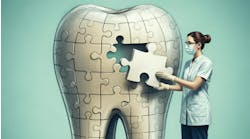by Bobbi Anthony
Most of us would agree that a majority of the functions we perform in a dental practice are done out of habit. Whether it's the way we greet patients, treat patients, or run our businesses, we have a tendency to do the things we've always done and, usually, in the way we've always done them. This isn't all bad, since it would take a great deal of thought and energy to constantly re-evaluate our every move. Still, this natural tendency, taken to the extreme, can create an environment of stagnation and stifle personal as well as professional growth.
It's no secret that competitive U.S. companies are always looking for the next new and creative approach to rethinking the way they do business. Companies are constantly trying to design and develop new and innovative processes for more insightful problem-solving, increased profitability, reduced overhead, and higher levels of customer loyalty. According to Mike Vance and Diane Deacon, who are widely regarded as the Deans of Creative Thinking, "Ideas that box us in are like sand traps of the mind ... they are a constant challenge." As the dean of Disney University, Vance spent seven years in charge of management development and training for Disney, as well as being a corporate advisor to companies like Apple Computer, AT&T, General Electric, Johnson & Johnson, and General Foods. His co-author, Diane Deacon, is the president of the Creative Thinking Association of America. Together, they coined the term "Thinking Outside of the Box" as a metaphor for successful creative thinking.
"The world will always need creative thinkers," emphasizes Vance. "We look outside the box to call upon our sense of vision and to imagine the best possible outcome. We also think out of the box to gain strategic advantage in our enterprises. The goal of being strategic is to give us a competitive advantage." Vance attributes Apple's early success to its adherence to the essential elements of highly creative and innovative thinking by individuals and the organization as a whole.
For the most part, innovation and creative thinking has not been a driving force in dental education. Mainstream dental education and training tends to be more task- and technique-focused, rather than creative in nature. And, though professional-continuing education courses available today are much more diverse than in the past, the majority are designed to focus attention on improvements in scientific knowledge, technology, and patient care. No one could argue the need for these courses; however, dependence solely on dental CE for professional growth may stifle our ability to think outside the box. Frequently, exploration of other fields of endeavor, seemingly unrelated to our own, can lead to new insights.
As an example, Southwest Airlines recently made some major cost-saving improvements based upon the observation of Indianapolis 500 racing teams. Since success for race-car drivers and their teams is dependent on reducing the amount of time spent on pit stops, incredible effort is expended to create fast, efficient maintenance and service procedures during races. This seems to me a great example of thinking outside the box. So, without re-inventing the wheel, how can we as dentists re-invent or recreate some of the principles of practicing dentistry to give us that strategic advantage or competitive edge? Vance and Deacon call it "replicating success." The question to ask ourselves is, "What are the correlations between dentistry and other successful businesses?"
Recently, while attending a Ritz-Carlton Leadership Course, I was struck by the number of company concepts that correspond with what we do. The one we hear about most often in dentistry is the concept which they call, "legendary customer service." The Ritz-Carlton has long been held up to epitomize the highest standard in customer service. This is the "what" the company does to create success.
However, there are many concepts related to the development of the company's organizational culture — the principles it has developed to create that level of service — that haven't been widely studied by our profession. These are the "whys" of the Ritz-Carlton's success in customer service and guest loyalty.
The Ritz-Carlton Company does not own properties; it is a management company. It is the successful development of leadership concepts and the organizational culture that has ensured the company's prominence in the hotel market. This goes beyond a beautiful environment and well-mannered employees. Horst Schulze, the CEO of the Ritz-Carlton Hotels, says, "Elegance without warmth is arrogance."
The real success of the company is due, in large part, to its dedication to vision and an empowerment-driven leadership style. Large amounts of resources are invested by the Ritz-Carlton in hiring the right person for the right position. "Quality starts with the employee selection, retention, and training," says Schulze. "My product is service. It isn't fancy bed sheets. My product is the nice attention to care that my employee gives you." According to the Gallup Survey, his hotels achieve 93 percent customer satisfaction. "That is not luck," he says.
In a service-industry sector where annual turnover is more than 100 percent, turnover at the Ritz-Carlton is 25 percent. "How do we hire in the industry?" he asks. "If the employee can walk about 10 yards without falling down drunk, we take them." The result is constant turnover. "I'd much rather take my time and not have to hire so many people. Untrained employees can screw up customers so badly they may never return," he says."
The Ritz-Carlton uses a company called Talent + in the employee selection process. "Everyone in the world has talent," says Doug Rath, the President of Talent +. "The important thing is to cast that talent in the right position."
The Ritz-Carlton is continually gathering statistical data to improve its performance. Satisfaction surveys are processed through the Gallup Organization, and the data is shared with employees through the continual employee-training process. Some statistical examples:
* A 5 percent point increase in customer loyalty could produce profit increases from 25 to 85 percent.* There is a direct relationship between overall customer satisfaction and revenue per available room.
According to the American Society for Quality:
* 9 percent of customers leave because of competitors.
* 10 percent of customers leave for other reasons such as a move, death, etc.
* 14 percent leave because of dissatisfaction with the product.
* 67 percent of customers leave because of an attitude of indifference on the part of a company employee.
How does all of this contrast to the traditional hiring and training of employees in the average dental practice? What level of customer service do most provide? If 67 percent of customers leave because of an attitude of indifference, what are we doing to select individuals that fit the profile of the job description, rather than hiring the person with the most experience? If you hire an individual for an administrative position and that person is answering the phones, you want to know that he or she has great people skills, as well as the ability to use the computer. In addition, each individual needs extensive training within his or her job description (Do you even have job descriptions?). How much time has been spent on development of the vision and on understanding and training for patient loyalty and satisfaction? However, if you only looked at the Ritz-Carlton's concept of customer service without looking deeper into its culture, you would miss the bigger picture that explains the "why" of the company's success.
Creative thinking requires courage, insight, and the ability to "see" from new and different perspectives ... out of the box. Inspirational leadership also is a necessary ingredient in the creative process. It encourages team participation and empowerment. Empowered teams utilize interdependent qualities to build quality organizations. The ability to thrive in competitive marketplaces is dependent on adherence to all of these essential elements.
Vision is an important part of the training process, since the way we treat our patients and our team should be based upon the practice vision. Vision is written and talked about often, but that doesn't mean that it's gone beyond the discussion stage, or that a "shared vision" has been developed by the team. To create "legendary customer service" within your practice, it's important for each person on the team to understand and visualize the way you want to treat patients. In today's competitive marketplace, you must:
1) Exceed, not just meet, patient expectations.
2) Understand the importance of patient retention. The number of new patients your practice generates is important, but so is the number you're losing out the back door.
3) Know and understand the procedures, services, and products available and how to communicate their value to your patients.
4) Understand the importance of patient referrals and how to ask for them. At the Ritz-Carlton, each employee is encouraged and empowered to make immediate decisions necessary for effective service recovery in the event an expectation is not met. In addition, employees are taught that the faster they are able to resolve a guest "opportunity," the less it will cost in monetary rewards to satisfy him or her. When dental professionals are empowered to make decisions based upon a shared vision, they become a true team. Just hiring people and putting them together in a room does not mean they will function as a team.
The question for dental professionals is, "How do you get out of the box and re-interpret the way you practice dentistry?" It makes good sense to look for correlations among other business organizations — and the Ritz-Carlton is only one of many — and replicate their success.
A good start would be to begin re-interpreting:
1. The way we traditionally hire dental-team members. Hire for talent, attitude, and ability for the particular job position.
2. The amount of time and financial resources we devote to training employees.
3. The amount of information we share with team members.
4. The leadership and managerial styles utilized by most dental practices.
5. Our understanding of conflict, resolution, and patient retention.
6. The important correlation between vision and overall success.





